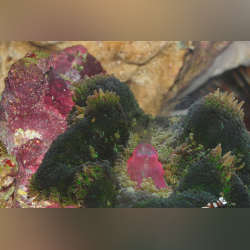Info
Muricella plectana Grasshoff, 1999
Muricella gorgonians are mainly found in the Indo-Pacific.
The warty gorgonian fan, as it is colloquially known, often lives in colonies in shaded areas, frequently under rocky overhangs, on sand and rubble.
Recommendation - the coral should be kept in a species-specific tank.
Feeding
Gorgonians do not have zooxanthellae and do not live off light. Azooxanthellate gorgonians do not host symbiotic algae that produce nutrients and energy through photosynthesis.
The pumps should be switched off before feeding. In order for the gorgonian to survive in the aquarium, each individual polyp must be fed sufficiently, i.e. daily or 3-4 times a week. Without feeding, the gorgonian will not survive in the aquarium. The polyps need a certain amount of time to absorb the food (granules or dust food (Ultramarin, Cyclop Eeze) or frozen food (lobster eggs, mysis)). If shrimp and fish are present, they will try to steal the food, so it is essential to feed these cohabitants beforehand.
Newly introduced gorgonian sticks can be stimulated with a liquid food, e.g., PolypLab Polyp, to encourage the individual polyps to open. Only then can feeding be carried out.
The better the individual polyps take up the food provided, the better the growth and reproduction rates will be.
Azooxanthellate corals eat suspensions, marine snow, microplankton, and other organic matter, which is their natural food.
The name warty gorgonian fan refers to the appearance of the gorgonian with retracted polyps (like a close-meshed net with knots).
The gorgonian can be found from shallow water to depths of about 50 meters.
The dwarf seahorse Hippocampus bargibanti lives in this fan gorgonian, where it is well camouflaged.
The color form of the dwarf seahorses that live on the red-polyp gorgonian Muricella plectana have a light gray body and red tubercles.
Muricella gorgonians are mainly found in the Indo-Pacific.
The warty gorgonian fan, as it is colloquially known, often lives in colonies in shaded areas, frequently under rocky overhangs, on sand and rubble.
Recommendation - the coral should be kept in a species-specific tank.
Feeding
Gorgonians do not have zooxanthellae and do not live off light. Azooxanthellate gorgonians do not host symbiotic algae that produce nutrients and energy through photosynthesis.
The pumps should be switched off before feeding. In order for the gorgonian to survive in the aquarium, each individual polyp must be fed sufficiently, i.e. daily or 3-4 times a week. Without feeding, the gorgonian will not survive in the aquarium. The polyps need a certain amount of time to absorb the food (granules or dust food (Ultramarin, Cyclop Eeze) or frozen food (lobster eggs, mysis)). If shrimp and fish are present, they will try to steal the food, so it is essential to feed these cohabitants beforehand.
Newly introduced gorgonian sticks can be stimulated with a liquid food, e.g., PolypLab Polyp, to encourage the individual polyps to open. Only then can feeding be carried out.
The better the individual polyps take up the food provided, the better the growth and reproduction rates will be.
Azooxanthellate corals eat suspensions, marine snow, microplankton, and other organic matter, which is their natural food.
The name warty gorgonian fan refers to the appearance of the gorgonian with retracted polyps (like a close-meshed net with knots).
The gorgonian can be found from shallow water to depths of about 50 meters.
The dwarf seahorse Hippocampus bargibanti lives in this fan gorgonian, where it is well camouflaged.
The color form of the dwarf seahorses that live on the red-polyp gorgonian Muricella plectana have a light gray body and red tubercles.







 Henning Wiese, Schweiz
Henning Wiese, Schweiz













